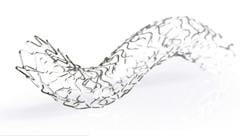
March 28, 2011 – Outcomes data from a subset analysis of the global e-HEALING registry were published online in the Journal of Interventional Cardiology and demonstrated the effectiveness of a stent in diabetic patients. The Genous Stent, from OrbusNeich, showed low definite and probable stent thrombosis (ST) comparable to non-diabetics.
The study investigated the 1,236 diabetic patients from the e-HEALING registry, including 273 insulin requiring diabetics (IRD) and 963 non-insulin requiring diabetics (NIRD). It then compared this cohort to the non-diabetic study participants.
The investigators found a target vessel failure (TVF) rate of 10 percent in diabetics, compared to 7.9 percent in non-diabetics. The TVF rates were 13.4 percent and 9 percent in IRD and NIRD, respectively. The higher TVF rates were driven mainly by a higher mortality hazard in both diabetic subgroups when compared to non-diabetics. The target lesion revascularization (TLR) rates were comparable in diabetics and non-diabetics, with 6.4 percent in diabetics versus 5.4 percent in non-diabetics. Definite or probable ST occurred in 1.1 percent of both diabetics and non-diabetics.
"Diabetics treated with percutaneous coronary intervention remain a high-risk subgroup," said Peter Damman, M.D., of the Academic Medical Center in Amsterdam and lead author of the paper. "These data show that Genous provides an effective alternative for managing thrombotic risk in this challenging group of patients."
The primary outcome for the e-HEALING registry was TVF at 12-month follow-up. TVF was defined as the composite of cardiac death or myocardial infarction (MI), unless unequivocally attributed to a non-target vessel, and target vessel revascularization (TVR).
The median age of the diabetic cohort was 64 years, 73 percent were male, and the mean body mass index (BMI) was 28.3. In diabetics, an average of 1.4 lesions per patient was treated, with an average of 1.1 Genous Stents per lesion. Of all lesions, 10 percent were bifurcation lesions, 97 percent were de novo lesions and 48 percent were type B2/C lesions.
"Patients with cardiovascular risk factors, including diabetes, have a reduced number of circulating endothelial progenitor cells (EPCs) that is due to either a direct influence on the mobilization and half-life of the EPCs or to a depletion of these cells caused by continuous endothelial damage or dysfunction,” said Michael Kutryk, M.D., Ph.D., clinician scientist and an interventional cardiologist at St. Michael's Hospital, Toronto, Canada. “Capturing circulating EPCs with the unique Genous technology promotes and restores the natural healing process that is impaired in diabetics."
Genous is OrbusNeich's patented EPC capture technology that promotes the accelerated natural healing of the vessel wall after the implantation of blood-contact devices such as stents. The technology consists of an antibody surface coating that attracts EPCs circulating in the blood to the device to form an endothelial layer that provides protection against thrombosis and modulates restenosis.
For more information: www.OrbusNeich.com.


 November 12, 2025
November 12, 2025 









